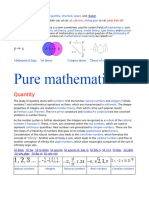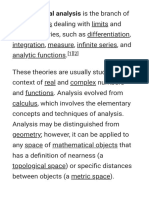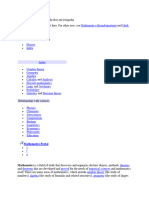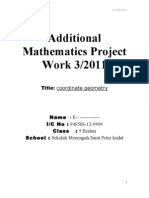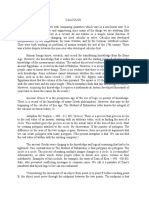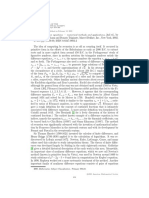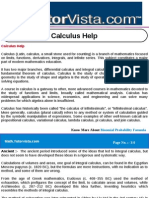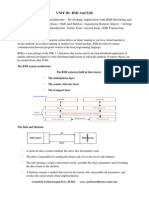C Is A: Mathematics Richard Courant Herbert Robbins England Oxford University Press
C Is A: Mathematics Richard Courant Herbert Robbins England Oxford University Press
Uploaded by
Audrey AlundayCopyright:
Available Formats
C Is A: Mathematics Richard Courant Herbert Robbins England Oxford University Press
C Is A: Mathematics Richard Courant Herbert Robbins England Oxford University Press
Uploaded by
Audrey AlundayOriginal Title
Copyright
Available Formats
Share this document
Did you find this document useful?
Is this content inappropriate?
Copyright:
Available Formats
C Is A: Mathematics Richard Courant Herbert Robbins England Oxford University Press
C Is A: Mathematics Richard Courant Herbert Robbins England Oxford University Press
Uploaded by
Audrey AlundayCopyright:
Available Formats
What Is Mathematics? is a mathematics book written by Richard Courant and Herbert Robbins, published in England by Oxford University Press.
It is an introduction to mathematics, intended both for the mathematics student and for the general public. First published in 1941, it discusses number theory, geometry, topology and calculus. A second edition was published in 1996 with an additional chapter on recent progress in mathematics, written by Ian Stewart. A Spanish translation of the second edition, Qu Son Las Matemticas?, was published in 2002. Millions of copies of unauthorised Russian and Chinese editions have been sold[1]. Although Robbins wrote most of the book, he received almost none of the royalties. Courant owned the copyright, and passed almost none of the money on to Robbins[2].
[edit]
Branches of Mathematics
Foundations
The term foundations is used to refer to the formulation and analysis of the language, axioms, and logical methods on which all of mathematics rests (see logic; symbolic logic). The scope and complexity of modern mathematics requires a very fine analysis of the formal language in which meaningful mathematical statements may be formulated and perhaps be proved true or false. Most apparent mathematical contradictions have been shown to derive from an imprecise and inconsistent use of language. A basic task is to furnish a set of axioms effectively free of contradictions and at the same time rich enough to constitute a deductive source for all of modern mathematics. The modern axiom schemes proposed for this purpose are all couched within the theory of sets, originated by Georg Cantor, which now constitutes a universal mathematical language.
Algebra
Historically, algebra is the study of solutions of one or several algebraic equations, involving the polynomial functions of one or several variables. The case where all the polynomials have degree one (systems of linear equations) leads to linear algebra. The case of a single equation, in which one studies the roots of one polynomial, leads to field theory and to the so-called Galois theory. The general case of several equations of high degree leads to algebraic geometry, so named because the sets of solutions of such systems are often studied by geometric methods. Modern algebraists have increasingly abstracted and axiomatized the structures and patterns of argument encountered not only in the theory of equations, but in mathematics generally. Examples of these structures include groups (first witnessed in relation to symmetry properties of the roots of a polynomial and now ubiquitous throughout mathematics), rings (of which the integers, or whole numbers, constitute a basic example), and fields (of which the rational, real, and complex numbers are examples). Some of the concepts of modern algebra have found their way into elementary mathematics education in the so-called new mathematics. Some important abstractions recently introduced in algebra are the notions of category and functor, which grew out of so-called homological algebra. Arithmetic and number theory, which are concerned with special properties of the integerse.g., unique
factorization, primes, equations with integer coefficients (Diophantine equations), and congruencesare also a part of algebra. Analytic number theory, however, also applies the nonalgebraic methods of analysis to such problems.
Analysis
The essential ingredient of analysis is the use of infinite processes, involving passage to a limit. For example, the area of a circle may be computed as the limiting value of the areas of inscribed regular polygons as the number of sides of the polygons increases indefinitely. The basic branch of analysis is the calculus. The general problem of measuring lengths, areas, volumes, and other quantities as limits by means of approximating polygonal figures leads to the integral calculus. The differential calculus arises similarly from the problem of finding the tangent line to a curve at a point. Other branches of analysis result from the application of the concepts and methods of the calculus to various mathematical entities. For example, vector analysis is the calculus of functions whose variables are vectors. Here various types of derivatives and integrals may be introduced. They lead, among other things, to the theory of differential and integral equations, in which the unknowns are functions rather than numbers, as in algebraic equations. Differential equations are often the most natural way in which to express the laws governing the behavior of various physical systems. Calculus is one of the most powerful and supple tools of mathematics. Its applications, both in pure mathematics and in virtually every scientific domain, are manifold.
Geometry
The shape, size, and other properties of figures and the nature of space are in the province of geometry. Euclidean geometry is concerned with the axiomatic study of polygons, conic sections, spheres, polyhedra, and related geometric objects in two and three dimensionsin particular, with the relations of congruence and of similarity between such objects. The unsuccessful attempt to prove the parallel postulate from the other axioms of Euclid led in the 19th cent. to the discovery of two different types of non-Euclidean geometry. The 20th cent. has seen an enormous development of topology, which is the study of very general geometric objects, called topological spaces, with respect to relations that are much weaker than congruence and similarity. Other branches of geometry include algebraic geometry and differential geometry, in which the methods of analysis are brought to bear on geometric problems. These fields are now in a vigorous state of development.
Applied Mathematics
The term applied mathematics loosely designates a wide range of studies with significant current use in the empirical sciences. It includes numerical methods and computer science, which seeks concrete solutions, sometimes approximate, to explicit mathematical problems (e.g., differential equations, large systems of linear equations). It has a major use in technology for modeling and simulation. For example, the huge wind tunnels, formerly used to test expensive prototypes of airplanes, have all but disappeared. The entire design and testing process is now largely carried out by computer simulation, using mathematically tailored software. It also includes mathematical physics, which now strongly interacts with all of the central areas of mathematics. In addition,probability theory and mathematical statistics are often considered parts of applied mathematics. The distinction between pure and applied mathematics is now becoming less significant.
Read more: mathematics: Branches of Mathematics Infoplease.com http://www.infoplease.com/ce6/sci/A0859533.html#ixzz1P2K8AHQN Geometry - it is the study of the spacial relation between points and lines. Number theory - it is the study of the patterns found in the numbers (the natural numbers). Statistics - is the summarization and organization of data.
Set theory - it is the study of objects called sets. A set is anything that is a collection of objects. Topology - this is the study of "open" sets. Real analysis - this is the study of the real number system (including "calculus" on the real line). Complex analysis - this is the study of the complex number system (including "calculus" on the complex plane). Algebra (also known as "group theory") - this is the study of any set along with an operator that follows certain rules (examples: real numbers, complex numbers, matrices, complete modular sets, rotational symmetries etc...) There are of course a whole bunch of other areas that are studied in math (knot theory, logic, mathematical philosophy, mathematical physics etc...) as well as variations on these different areas. For example non-euclidian geometry is the study of geometry with a set of slightly different assumptions about how points and lines interact. In this geometry you get strange results like interior angles of triangles add to less than 180 degrees. Geometry (Ancient Greek: ; geo- "earth", -metri "measurement") "Earth-measuring" is a branch of mathematics concerned with questions of shape, size, relative position of figures, and the properties of space. Geometry is one of the oldest mathematical sciences. Initially a body of practical knowledge concerning lengths, areas, and volumes, in the 3rd century BC geometry was put into an axiomatic form by Euclid, whose treatmentEuclidean geometryset a standard for many centuries to follow. Archimedes developed ingenious techniques for calculating areas and volumes, in many ways anticipating modern integral calculus. The field of astronomy, especially mapping the positions of the stars and planets on the celestial sphere and describing the relationship between movements of celestial bodies, served as an important source of geometric problems during the next one and a half millennia. A mathematician who works in the field of geometry is called a geometer.
You might also like
- Gap All PDFDocument139 pagesGap All PDFdavonesNo ratings yet
- Linear Algebra For Computational Sciences and Engineering - Ferrante Neri (Springer, 2016)Document472 pagesLinear Algebra For Computational Sciences and Engineering - Ferrante Neri (Springer, 2016)Yannick AssoumanNo ratings yet
- History of MathematicsDocument4 pagesHistory of MathematicsAilyn Joy BesanaNo ratings yet
- Cis Itsm BlueprintDocument8 pagesCis Itsm BlueprintNaresh KumarNo ratings yet
- Mathematical AnalysisDocument11 pagesMathematical AnalysisjosgauNo ratings yet
- Toan HocDocument6 pagesToan HocvietluuNo ratings yet
- (Mathematics) : Report AboutDocument12 pages(Mathematics) : Report AboutSangin ZandiNo ratings yet
- Mathematical AnalysisDocument24 pagesMathematical AnalysisSire MonNo ratings yet
- StructureDocument2 pagesStructurepoojaNo ratings yet
- History: Mathematical Analysis, Which Mathematicians Refer To Simply As Analysis, Has ItsDocument5 pagesHistory: Mathematical Analysis, Which Mathematicians Refer To Simply As Analysis, Has Itsashi1564No ratings yet
- 1.1-MathematicsDocument42 pages1.1-Mathematicslearningbrain1985No ratings yet
- The Depth and Beauty of MathematicsDocument4 pagesThe Depth and Beauty of Mathematicspigis58346No ratings yet
- Topic - MAthematicsDocument21 pagesTopic - MAthematicsAG05 Caperiña, Marcy Joy T.No ratings yet
- Combinatorics: Combinatorics Is An Area of Mathematics Primarily Concerned With Counting, Both As A Means and An EndDocument9 pagesCombinatorics: Combinatorics Is An Area of Mathematics Primarily Concerned With Counting, Both As A Means and An EndK. M. Junayed AhmedNo ratings yet
- Mathematics PortalDocument10 pagesMathematics PortalannirmalaNo ratings yet
- TH THDocument1 pageTH THsrirampratap2401No ratings yet
- New Text DocumentDocument1 pageNew Text Documenterenyeager9935No ratings yet
- 12th Grade MathDocument4 pages12th Grade Mathcircleteam123No ratings yet
- Mathematics - WikipediaDocument42 pagesMathematics - WikipediaBuena QuintinNo ratings yet
- History of Math ReviewerDocument8 pagesHistory of Math ReviewerNelmida, Henriane P.No ratings yet
- English for Mathematics_ban GocDocument205 pagesEnglish for Mathematics_ban GocĐoàn Hồng ÁnhNo ratings yet
- Areas of MathematicsDocument7 pagesAreas of MathematicsjosebardamuNo ratings yet
- Mathematical Analysis (Group 3)Document10 pagesMathematical Analysis (Group 3)Jan UnayNo ratings yet
- Additional Mathematics Project Work 3 2001Document40 pagesAdditional Mathematics Project Work 3 2001Mis Adilina100% (3)
- Mathematics - WikipediaDocument263 pagesMathematics - Wikipediashrimati.usha.sharmaNo ratings yet
- Introduction and Basic DefinitionsDocument14 pagesIntroduction and Basic DefinitionsattaNo ratings yet
- Space (Mathematics)Document9 pagesSpace (Mathematics)user2127No ratings yet
- Linear Algebra For Computational EngineeringDocument21 pagesLinear Algebra For Computational EngineeringCovenant Adeogo0% (1)
- Mathematical AnalysisDocument4 pagesMathematical AnalysisRoxiNo ratings yet
- The 6 Main Brances of MathsDocument3 pagesThe 6 Main Brances of Mathssamiouzampaligre621No ratings yet
- The History of The Concept of Function and Some Educational ImplicationsDocument9 pagesThe History of The Concept of Function and Some Educational ImplicationsMahmoud BouazizNo ratings yet
- HIMA PROJECT Mark Joseph UrianDocument72 pagesHIMA PROJECT Mark Joseph UrianLydia AlbanNo ratings yet
- Analytic GeometryDocument1 pageAnalytic GeometryPaolo RoxasNo ratings yet
- Analytic GeometryDocument37 pagesAnalytic GeometryKorinta Kori100% (1)
- On The Histories of Linear Algebra The Case of Linear SystemsDocument28 pagesOn The Histories of Linear Algebra The Case of Linear SystemsArnulfo Ariel Rios Aparicio100% (1)
- Math - Calculus EssayDocument4 pagesMath - Calculus Essayapi-327846927No ratings yet
- Model Logic MathematicalDocument3 pagesModel Logic Mathematicaljordan lupeNo ratings yet
- Why Study MathematicsDocument2 pagesWhy Study MathematicsAryo WibisonoNo ratings yet
- 1 AakzDocument14 pages1 Aakzadehcm2021tsiNo ratings yet
- Mathematics DefintionsDocument8 pagesMathematics DefintionsSikandar KhanNo ratings yet
- N N 1 N N 1 N N 1 N 1 N N 1 N 1Document4 pagesN N 1 N N 1 N N 1 N 1 N N 1 N 1Tayyab HassnainNo ratings yet
- Analytic GeometryDocument3 pagesAnalytic GeometryFroiland SampianoNo ratings yet
- Mathematics Introduction For MSCDocument52 pagesMathematics Introduction For MSC34plt34No ratings yet
- Differential Geometry Ideas in Financial MathematicsDocument4 pagesDifferential Geometry Ideas in Financial MathematicsVishal TamraparniNo ratings yet
- MathDocument1 pageMathKevin OinezaNo ratings yet
- Questionnaire Reading NDocument7 pagesQuestionnaire Reading NNaomilambert052005No ratings yet
- Mathematics - WikipediaDocument40 pagesMathematics - WikipediaNameNo ratings yet
- Alg 8Document3 pagesAlg 8nayellemaepamogasNo ratings yet
- Analysis and Geometry in The Development of The Theory of Partial Differential Equations of The 1st Order in The 18th and 19th CenturyDocument8 pagesAnalysis and Geometry in The Development of The Theory of Partial Differential Equations of The 1st Order in The 18th and 19th CenturyWeb SiteNo ratings yet
- Mathematics: See AlsoDocument5 pagesMathematics: See AlsoEduardo RojasNo ratings yet
- MathsDocument8 pagesMathsyogeshabnaveNo ratings yet
- Applications Applications Applications: Pre-Calculus Integration Pre-Calculus Integration Pre-Calculus IntegrationDocument1 pageApplications Applications Applications: Pre-Calculus Integration Pre-Calculus Integration Pre-Calculus Integrationdwarika2006No ratings yet
- Hayana Mardiyah Harahap - 8216172012Document8 pagesHayana Mardiyah Harahap - 8216172012Rizkiyan HadiNo ratings yet
- Mathematics Quiz BookDocument218 pagesMathematics Quiz BookNadeem Ahmed100% (2)
- Ebrahim-2016 EvolutionOfNumberMathematics 6ppDocument6 pagesEbrahim-2016 EvolutionOfNumberMathematics 6ppAssad EbrahimNo ratings yet
- Project Additional Mathematic 2011 Work 3: Saidatul Syafinaz Binti Mior Ahmad 6/27/2011Document30 pagesProject Additional Mathematic 2011 Work 3: Saidatul Syafinaz Binti Mior Ahmad 6/27/2011Ahmadi AhmadNo ratings yet
- Calculus HelpDocument4 pagesCalculus Helpapi-140032165No ratings yet
- 1 - Dms Introduction To Dms and Set TheoryDocument43 pages1 - Dms Introduction To Dms and Set TheoryAnime FreakNo ratings yet
- Higher Geometry: An Introduction to Advanced Methods in Analytic GeometryFrom EverandHigher Geometry: An Introduction to Advanced Methods in Analytic GeometryNo ratings yet
- USB Host - Android DevelopersDocument8 pagesUSB Host - Android DevelopersRestu AdtyaNo ratings yet
- SS Assignment 3 22-23 Sem 1Document1 pageSS Assignment 3 22-23 Sem 1Ambica AnnavarapuNo ratings yet
- Sheet 2Document6 pagesSheet 2mernasamy171No ratings yet
- Cs408 Mid Term by JuanidDocument36 pagesCs408 Mid Term by JuanidInformation everythingNo ratings yet
- 85010-0129 -- Signature Driver Controller ModulesDocument4 pages85010-0129 -- Signature Driver Controller Modulesrodrigo plazaNo ratings yet
- Telephone Messages: Question CardsDocument2 pagesTelephone Messages: Question CardsLera TNo ratings yet
- Computer Revolution The Change in Modern Society - CopieDocument2 pagesComputer Revolution The Change in Modern Society - CopieAd ElNo ratings yet
- Axis Gatepass Presentation - Web For RGP-NRGPDocument20 pagesAxis Gatepass Presentation - Web For RGP-NRGPShailendra GoyalNo ratings yet
- Sad NotesDocument128 pagesSad NotesgauravNo ratings yet
- Civil 17 BtechDocument86 pagesCivil 17 Btechv.tejashwini goudNo ratings yet
- Resume 2Document2 pagesResume 2melissaperezNo ratings yet
- FInal Year ProjectDocument5 pagesFInal Year ProjectMuhammad MustafaNo ratings yet
- Jaipuria Institute of Management, Lucknow: 4 Trimester (Batch 2019-21) End Term ExaminationsDocument1 pageJaipuria Institute of Management, Lucknow: 4 Trimester (Batch 2019-21) End Term ExaminationsKritika ChauhanNo ratings yet
- DSAP-Lecture 5 - Array Based SequencesDocument45 pagesDSAP-Lecture 5 - Array Based SequencesAnnisa NurfadilahNo ratings yet
- AM and FM Transmitter Maintenance: GeneralDocument9 pagesAM and FM Transmitter Maintenance: GeneralRael EtinadoNo ratings yet
- Thesis PHD UpmDocument4 pagesThesis PHD Upmlisabrownomaha100% (2)
- CD Lab ManualDocument55 pagesCD Lab Manualkalai100% (1)
- CORMAY CK-MB CALIBRATOR - ADocument4 pagesCORMAY CK-MB CALIBRATOR - ANghi NguyenNo ratings yet
- Elephant Roads: 17 Years of Postgres Forks and VariantsDocument53 pagesElephant Roads: 17 Years of Postgres Forks and VariantsShrikant TirkiNo ratings yet
- Andrea Nicole Valencia: Career ObjectivesDocument3 pagesAndrea Nicole Valencia: Career ObjectivesReginald TuazonNo ratings yet
- ) Meri College of Engineering and Technology, (Sampla)Document56 pages) Meri College of Engineering and Technology, (Sampla)Abhishek GuptaNo ratings yet
- UntitledDocument22 pagesUntitledHappyNo ratings yet
- Information: Analog/Isdn/Geocentrex TelemeetingDocument8 pagesInformation: Analog/Isdn/Geocentrex TelemeetingEugen BleulerNo ratings yet
- Advance Java Notes For B.C.a (2012) Unit III, IV, V.Document29 pagesAdvance Java Notes For B.C.a (2012) Unit III, IV, V.nikhil_701aNo ratings yet
- Energy-Saving Servo Motor: PerfaceDocument5 pagesEnergy-Saving Servo Motor: PerfaceImronNo ratings yet
- HangmanDocument10 pagesHangmanPaul Allen DungdungNo ratings yet
- Installing Windows 10 ARM64 Into Lumia 950 XL: Read This Guide CarefullyDocument12 pagesInstalling Windows 10 ARM64 Into Lumia 950 XL: Read This Guide CarefullyRubens Tanioka100% (2)
- Atlas Copco Tools Talk Tps ManualDocument76 pagesAtlas Copco Tools Talk Tps ManualClaudio50% (2)






